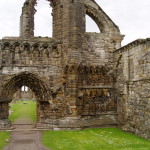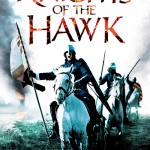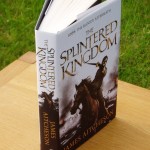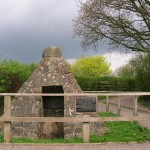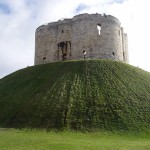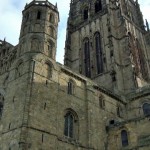Devoted readers of this blog will remember that last June I ventured north to the University of St Andrews for a four-day conference on The Middle Ages in the Modern World, exploring how our medieval past has been remembered, depicted, referenced, re-created and reconstructed in more
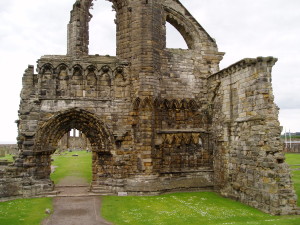
The ruins of St Andrews Cathedral. At 119 metres (391 feet) in length, it’s the largest church ever to have been built in Scotland.
As well as giving a paper of my own on representing the Middle Ages in fiction, I also had the chance to meet and share ideas with historians and people from a wide range of other academic disciplines whose work involves the medieval in one way or another.
I was also privileged to be able to attend the lecture that closed the conference, which was delivered by Nobel Prize-winning poet Seamus Heaney in what was probably one of his final public appearances before he died just a couple of months later.
Five of the keynote lectures, including Heaney’s, were recorded on video and have now been posted on the conference website for anyone interested in getting a taste of what the conference was all about. The five lectures are:
Saints’ cults and celebrity: the medieval legacy
James Robinson (National Museums Scotland)
Adapting medieval romance
Felicitas Hoppe (author and translator)
The worlding of medievalism: past and present in the early anthropocene
Bruce Holsinger (University of Virginia)
European ethnicity: does Europe have too much past?
Patrick Geary (Institute for Advanced Study, Princeton)
“Feinyit Fablis and Ane Cairfull Dyt”?: a Reading with Commentary
Seamus Heaney (Nobel Prize-winning poet)
The week following the conference, the British Academy in London held a special event with Patrick Geary and broadcaster, actor and writer Terry Jones, chaired by Dr Chris Jones from the University of St Andrews, in which they reprised their presentations and discussed the continuing relevance of the Middle Ages. The video of this event is also now online on the British Academy website.
All of the lectures are well worth watching if you have the chance. Between them they give a fairly good idea of the variety of subjects that were discussed over the four days, exploring how ideas and misconceptions of the Middle Ages have informed, and are reflected, in disciplines as wide-ranging as literature, politics and even climatology, which was the focus of Bruce Holsinger’s particularly excellent talk – just one of my many highlights of the conference.
In case you missed them the first time around, catch up with Part One and Part Two of my report from “The Middle Ages in the Modern World”.
The wait is over! Knights of the Hawk, the third novel in the Conquest series, is published today in the UK by Preface, both in hardback and also – for the more digitally inclined among you – as an e-book.
Autumn, 1071. Five years after the fateful Battle of Hastings, only a desperate band of
The wait is over! Knights of the Hawk, the third novel in the Conquest series, is published today in the UK by Preface, both in hardback and also – for the more digitally inclined among you – as an e-book.
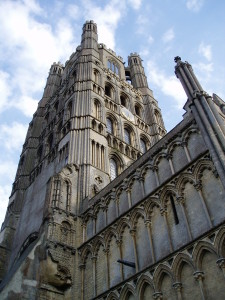
The cathedral at Ely, built on the site of the Anglo-Saxon monastery which Hereward and his fellow rebels used as their base in their struggles against the Normans in 1071.
Thus begins Tancred’s latest adventure, which sees him facing his greatest challenge yet as he ventures from the marshes of East Anglia to the wild, storm-tossed seas of the north in pursuit of love, of honour, and of vengeance.
Over the course of the next month I’ll be travelling the length and breadth of the country doing talks and book signings and panel events. It all kicks off on Tuesday 29 October when I’ll be launching Knights at the White Horse Bookshop in Marlborough. After that I’ll be travelling up to Doncaster to a signing at Waterstones in the Frenchgate Centre on Saturday 2 November, and then over the course of the next few weeks you’ll be able to find me in Salisbury, Bedford and Cambridge.
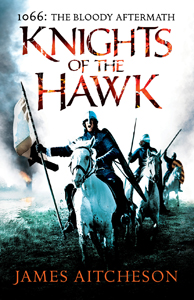
Knights of the Hawk • James Aitcheson • Preface • 448 pp. • Hardback • £16.99
And before you ask, Knights of the Hawk is not the end of the series. Tancred will ride again soon! I’m currently in the middle of researching my next project, which I’m very excited about. I’ll be revealing more details about that over the coming months.
First copies of The Splintered Kingdom arrived recently and look amazing, as I hope you will agree. Although of course the words contained within its cover and even the jacket design are now very familiar to me, seeing the finished book in the flesh, so to speak, is still a tremendous thrill. I’m looking forward
First copies of The Splintered Kingdom arrived recently and look amazing, as I hope you will agree. Although of course the words contained within its cover and even the jacket design are now very familiar to me, seeing the finished book in the flesh, so to speak, is still a tremendous thrill. I’m looking forward to spotting it on bookshelves when it’s published in just a few days from now, on Thursday 13th September.
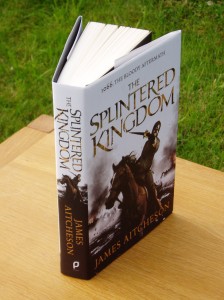 Set one year on from the end of Sworn Sword, it once more features Tancred, who has been rewarded for his exploits with a lordship on the turbulent Welsh Marches. But as the enemy stirs, his hard-fought gains are soon placed in peril. Under siege on all sides, the Norman realm begins to crumble, leading Tancred to face his sternest challenge yet. It will be either his chance for glory, or his undoing.
Set one year on from the end of Sworn Sword, it once more features Tancred, who has been rewarded for his exploits with a lordship on the turbulent Welsh Marches. But as the enemy stirs, his hard-fought gains are soon placed in peril. Under siege on all sides, the Norman realm begins to crumble, leading Tancred to face his sternest challenge yet. It will be either his chance for glory, or his undoing.
If you fancy a sneak preview of what’s in store, the synopsis and even a downloadable extract from the novel (PDF) can be found here.
I’ll be launching the novel with several events this coming week, starting with a talk and signing in Marlborough in Wiltshire on the evening of Tuesday 11th. Hosted by the White Horse Bookshop, who organised a highly successful signing last year on the publication of Sworn Sword, this will be an exclusive opportunity to get your hands on the book before it goes on nationwide release two days later.
Then on the evening of Friday 14th, I’ll be continuing the book tour with a talk at Waterstones in Salisbury. I’ll be discussing what inspired me to write about the Norman Conquest and how I go about my research, and giving readings from the new novel. That’s followed by a signing session the following morning, on Saturday 15th, at the wonderful Cotwold Bookstore in the picturesque town of Moreton-in-Marsh in Gloucestershire.
The following week, I’ll be attending History in the Court at Goldsboro Books in London along with a host of other writers of historical fiction and non-fiction. Now in its second year, this event is a great opportunity to mingle with your favourite authors and other fans of historical writing.
Full details of these and all my other upcoming signings, talks and festival appearances, including start times and how to obtain tickets, can be found as always on my Events page. I’m adding new dates to my calendar all the time, so if you can’t make it to any of those currently listed, keep checking back to see if I’ll be appearing soon in your area.
As many of you will have heard, the Festival of History at Kelmarsh Hall on 14-15 July had to be cancelled after heavy overnight rain led to the local river bursting its banks and flooding the site. If you want to get some idea of just
As many of you will have heard, the Festival of History at Kelmarsh Hall on 14-15 July had to be cancelled after heavy overnight rain led to the local river bursting its banks and flooding the site. If you want to get some idea of just how wet it was, take a look at the photos on the BBC History Magazine website.
The flooding meant that the planned Festival of Historical Writing also couldn’t go ahead, including the panel discussion in which myself and fellow writers Robyn Young, Angus Donald and John Man were due to talk about “the heroes of history”. My own chosen subject was William the Conqueror – not the most obvious choice for many people today, perhaps, although the Normans at the time certainly would have regarded him as a hero despite his chequered career.
As disappointed as I was to miss out on the chance to speak, and also to see the planned Battle of Hastings re-enactment, I can only imagine how disappointing it must have been for all those visitors who travelled many miles especially for the Festival only to be turned away. There has been some tentative talk of possibly resurrecting the heroes panel at some future event, although nothing has been confirmed. In the meantime I might present my case for the Conqueror here on the blog, so watch this space.
Thwarted by the Northamptonshire weather but still determined to see some history, I crossed the border into Leicestershire to visit Bosworth Battlefield, the site of the famous clash in August 1485 between the forces of Henry Tudor and King Richard III, which saw the latter lose his life and the former claim the crown of England (as Henry VII).
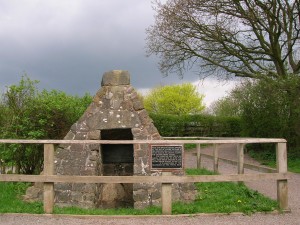
The well from which Richard III is said to have drunk before the Battle of Bosworth on 22 August 1485.
The later Middle Ages, the Wars of the Roses and the rise of the Tudor dynasty present largely unfamiliar territory for me, being mainly an early medieval specialist, but walking the mile-and-a-half-long Battlefield Trail that leads around the site gave me a real insight into the period. Display panels dotted around the site describe the historical context and tell the story of the battle, and also suggest how the countryside might have looked in the late fifteenth century and how the armies might have approached each other on that fateful summer’s day, taking into account recent research into the site.
The real brilliance, however, comes in the audio installations located at key points on the Trail, which describe how ordinary soldiers on both sides might have felt on the march to Bosworth and on the night prior to going into battle, exploring the tension and the anxiety in a way that really brings the battle to life. There is a small charge to get into the exhibition at the Heritage Centre, but it’s free to enter the Country Park and walk around the Battlefield Trail, which I would thoroughly recommend if you get the chance.
Who was the hero and who was the villain in the contest between Henry Tudor and Richard III? The site makes no judgements, but allows visitors to make up their own minds about the two rivals for the crown. Certainly some of the supporting players were less than savoury characters, such as the duplicitous Stanley brothers who betrayed Richard at the critical moment in order to secure greater glory and set themselves up as kingmakers. Perhaps there’s a novel in there somewhere…
*
The Bosworth Battlefield Heritage Centre is open from February to December; the Country Park is open all year round.
Last week I ventured northwards to York for the annual Jorvik Viking Festival. For the 27th year, Norsemen took over the city for February half-term week and set up camp in the streets, even bringing their longship into Coppergate Square for those queueing up outside the Jorvik Viking Centre to admire.
I was in York
Last week I ventured northwards to York for the annual Jorvik Viking Festival. For the 27th year, Norsemen took over the city for February half-term week and set up camp in the streets, even bringing their longship into Coppergate Square for those queueing up outside the Jorvik Viking Centre to admire.
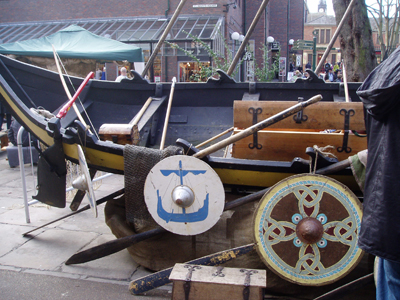
The Viking longship in Coppergate Square, outside the Jorvik Viking Centre.
I was in York to talk about Sworn Sword, the novel’s connection with the city, and what it was about York that made it such a battleground during the mid-eleventh century as English, Norman and Scandinavian forces all struggled to capture and control it. At the end I also gave a special sneak preview reading from the very first chapter of the sequel, which will be released in hardcover on 6 September (more details on that to follow soon).
York has a long history dating back to the Roman period. By the time of the Norman Conquest it was the second biggest city in England (after London): the chief town of the north of the kingdom; a major manufacturing centre for metalwork, woodwork, glass and jewellery; and a burgeoning port and trading hub with links all across Europe and beyond, even as far as Byzantium and Samarkand in modern-day Uzbekistan. In 1069 when Sworn Sword is set it would have been a fantastically vibrant place to be, with people from all cultures mixing together and a lot of wealth being brought in from abroad.
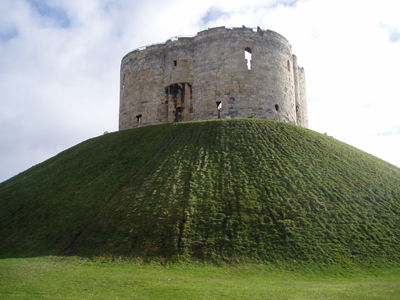
Clifford's Tower, York - the thirteenth-century keep that stands on the site of the original castle.
Militarily speaking, York was also a crucial strong-point, and whoever controlled it tended to hold sway over the vast province known as Northumbria that stretched from the Humber Estuary in the south to the borders of the Scottish kingdoms in the north.
For that reason it formed the location for some of the fiercest struggles for power witnessed in this period, both before the Conquest – the Battle of Stamford Bridge, for example, which was fought only a few miles away between the namesake kings Harold Godwineson of England and Harald Hardrada of Norway – and afterwards too. It’s not too much of an exaggeration to say that York was where in many ways the future of England was decided in those fateful years.
I visited the city a few years ago as part of my research for the novel, so that I could get a feel for the scale of the medieval city and the lie of the land. Not much of Conquest-era York survives today, but by walking the streets I was able to get a feel for the richness of the place’s history. On my return last week I also took the time to snap some pictures, the best of which you can see on this page!
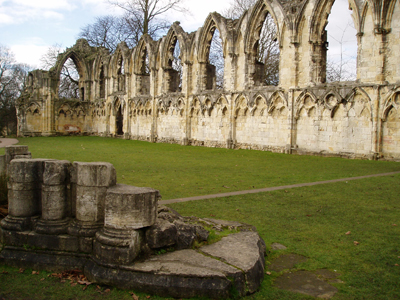
The ruins of St Mary's Abbey outside Bootham Bar to the northwest of medieval York.
One of the locations that I revisited last week was St Mary’s Abbey (pictured above), the ruins of which now lie in the Yorkshire Museum Gardens. St Mary’s was in its turn built on the site of an earlier foundation dedicated to St Olave in a district once known as Earlsburgh, which it is suggested received its name from a fortified palace belonging to the Anglo-Scandinavian earls of Northumbria that used to stand nearby.
That palace is the same one referred to in Sworn Sword as the residence of the real-life vicomte (sheriff) of York, William Malet, who was installed by King William I after the city was first captured by the Normans in 1068. Even though the site looks very different nowadays, somehow the knowledge that I was treading the same ground as my characters helped me visualise those scenes when I came to write the novel.
Thanks to the folks at York Archaeological Trust and the Jorvik Viking Centre for inviting me to come and talk. It was a pleasure to meet so many other historically-minded people and to share my love of this period. I hope it’s not too long before I find myself back in York. And for those of you reading this who have a special interest in all things Norse-related, the good news is that there are more Vikings to come in Books 2 and 3 – watch this space!
*
For information about other Viking- and medieval-themed events taking place in and around York, visit the Jorvik Viking Centre website.
This week I returned to the place where Tancred’s story begins – to Durham, where the city’s annual Book Festival has been taking place this month. An enthusiastic audience joined myself and my event host, Dr Giles Gasper, lecturer in medieval history at Durham University, for a discussion about Sworn Sword and its connection with
This week I returned to the place where Tancred’s story begins – to Durham, where the city’s annual Book Festival has been taking place this month. An enthusiastic audience joined myself and my event host, Dr Giles Gasper, lecturer in medieval history at Durham University, for a discussion about Sworn Sword and its connection with the city.
One of the questions I was asked was why I chose Durham in particular as the place to begin the novel. In fact the battle that forms the opening chapters was a real-life event that took place on or around 28 January 1069, and it’s spoiling none of the plot to say that it marked a significant turning-point in the story of the Conquest. Indeed this was the biggest defeat that the Normans had suffered since arriving on these shores more than two years previously.
Around Christmas 1068, William the Conqueror appointed Robert de Commines, Tancred’s lord, as Earl of Northumbria, the only part of England that had thus far refused to acknowledge him as king. Together with his army – the sources disagree on exactly how many men – Robert marched to subdue the recalcitrant northerners and take the province by force. Soon after arriving in Durham, however, the earl and his forces were routed in a surprise attack under the cover of darkness. The Normans were cut down in the streets and Robert himself was killed. There were few survivors.
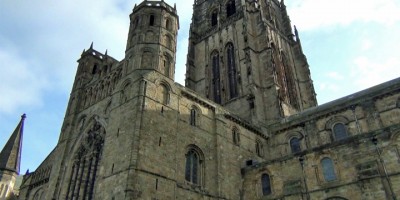
View of the tower and north transept of Durham Cathedral.
Walking around the city on my visit there this week, I was reminded just how dramatic a location Durham is, and how its very geography makes it a fascinating setting for a battle. The castle and the cathedral that nowadays dominate the skyline had not yet been built by 1069, but the peninsula on which they are built would have made this a naturally defensible site, protected on three sides by water and by steep inclines that would make any direct assault difficult except from the north. While there is little explicit evidence for any fortification on the site before then, to my mind it seems likely that a stronghold or fastness of some kind must have existed, as I have suggested in Sworn Sword.
Whether or not such defences existed at the time, the very fact that the Northumbrians were able to defeat the Normans here was by all accounts an impressive achievement, and a famous victory. Conversely, to the Normans this would have been seen as a major setback to their conquest of the north. The loss of so many men in one night would not only have dented their confidence but in addition must have placed a very real strain on their defences, especially once the enemy began their southwards march not long after.
The Durham connection was just the starting-point of a great discussion about the Norman Conquest and historical fiction. Topics ranged from the use of Old English place-names in the novel to getting inside the medieval mind, the importance of research and site visits, and my plans for future novels in the series. I certainly enjoyed myself and I hope that my audience did too.
Many thanks to all those involved in the organisation and smooth running of this year’s Festival. Particular thanks also go to my host for the event, Dr Gasper, who generously gave his time after the talk to give me an exclusive tour of Durham Castle’s Norman chapel, which is normally off-limits to the public. One of the earliest stone chapels of its kind known to have been built in England, it is thought to date from the 1080s when it was attached to the house of the Bishop of Durham, who probably used it as a private place of worship. It was a privilege to be allowed access to such impressive architecture, and an unexpected bonus on my northern travels.
I’m hoping to be back in Durham at some point in the New Year, and in February I’ll also be visiting York, the centrepoint for much of the action in Sworn Sword, where I’ll be giving a talk at the Jorvik Viking Festival – more details to follow in due course. Keep checking my Events page for further information about all my upcoming appearances.
*
The Durham Book Festival runs until tomorrow, Sunday 23 October, with further events for young writers continuing through half-term week to Friday 28 October. For more information visit the Festival website.

